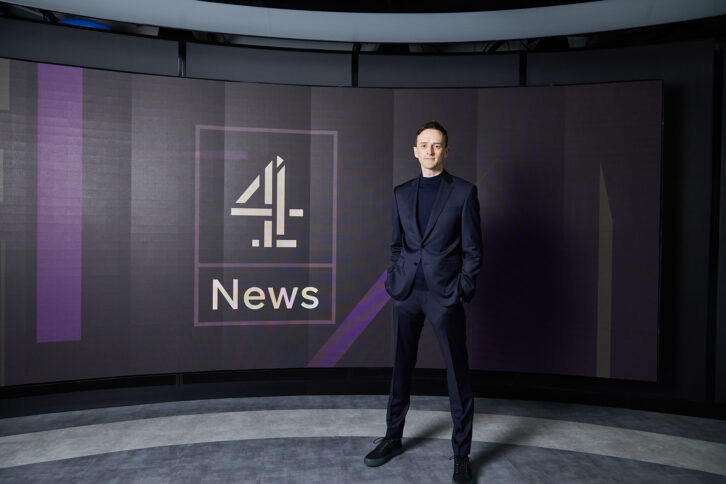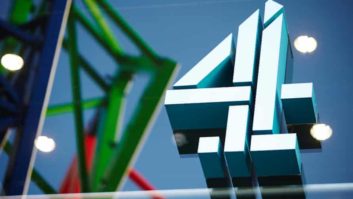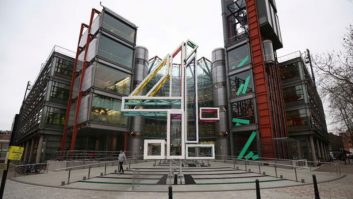Earlier this month Channel 4 News debuted its new, permanent Leeds-based newsroom.
The broadcaster has operating out of a temporary newsroom since it began broadcasting from the city in early 2022. The aim of the new permanent studio is to support the delivery of its data-led journalism, with Channel 4 News’ new data correspondent Ciaran Jenkins based in Leeds.
The Leeds newsroom has been “years in the making” Jon Roberts, director of technology, production and innovation at ITN tells TVBEurope, and was always part of the channel’s plans to develop its footprint in the city.
“From the very outset of the conversation about the relocation of the Channel 4 headquarters, there’s been a conversation with Channel 4 News, with an ambition to get to where we now are,” he explains.

ITN and Channel 4 wanted to establish their new base in Leeds as quickly as possible, which was they took the decision to initially build a temporary facility. “We built that more in line with how we build a typical remote presentation. Obviously presenting remotely is something we do regularly,” adds Roberts. “We knew we wanted to take our time for this permanent build and really lay in some smart infrastructure, as well as thinking about the disaster recovery offering, and we knew we couldn’t do that very quickly.”
Once the temporary studio was up and running, the focus turned to building the permanent facility. ITN worked with ES Broadcast throughout the project.
From the outset, ITN wanted the Leeds operation to be fully remote, with all cameras, lights, and sound operated out of the company’s HQ in Grays Inn Road, London. “In the conversations with Channel 4 it was clear that not only did we want to build Leeds for all the great reasons of what it’s doing for the editorial agenda, but also to give them better resilience, particularly off the back of some disaster recovery challenges they and others went through with Red Bee,” explains Roberts.
“We decided quite early on but that it didn’t stack up for us to build a control room in Leeds. The initial thought was to create strong connectivity from London to Leeds which we take through our Slough data centre, to be able to bridge into AWS so that we can build a cloud production facility for when we have an unfortunate event at Grays Inn Road, and then to select our technologies based on being able to operate in that environment.”
Key technologies used to connect Leeds and London include Riedel’s Bolero for talkback, Ross Video’s Ultrix routing platform, EVS’s Cerebrum as a remote control to enable the routing, Shotoku cameras that are all robotically controlled, and ETC lighting. “We also have control of some colour addressable light boxes, including in the desk, so we can tweak the tone of the studio.,” adds Roberts.
Both London and Leeds are operated out of PCR 6 at Grays Inn Road. The video wall in Leeds is operated by Viz Multiplay, which has been integrated into Viz Director in London. “We don’t actually have any Viz operators on our operation, our vision mixers are able to control both the Viz infrastructure for playing out named supers and fullframe graphics through the London control room, but at the same time control the wall in Leeds, which means we end up with a single playlist for both a wall in London and a wall in Leeds,” says Roberts.
“We tried to take that integrated approach throughout. We’ve integrated the camera controls so that we have a single position,” he continues. “Again, we don’t have dedicated controllers. For that we’ll have our lighting director supplemented by one of our camera operators, able to control both the cameras in the London studio and in the Leeds studio through the same interface. Same for audio, one audio desk, one comms system.”
In the studio
One of the key features of the Leeds studio is that it has real windows as part of the set – something that you rarely see on news programmes. As the production team can’t control the sun, they’ve had to employ special measures, explains Sam Parker, ITN’s studio and technology manager. “We have a treatment on the windows of a .6 or .9 ND, which does help,” he says. “We also have the video fins, which kind of act as sun blockers as well, depending on the position you have guests. They obviously have a role to play in blocking out the sun at the moment because it literally sets behind the presenter.

“I’ve actually put another treatment over the top windows because we find at the moment that’s where most of the light is coming through. When the sun does come through, it looks really nice. To actually have sunlight into a newsroom is quite a strange phenomenon,” he adds.
Parker has also been instrumental in the decision to donate the technology from the temporary studio to the School of Media and Communication at Leeds University. “It was an idea I came up with alongside Channel 4’s head of regions, Sunita Bhatti,” he explains. “We wanted to reach out to the universities to utilise the technology because otherwise it was just going to be disposed of and it’s a perfectly good set.”
Parker believes it’s important for a company like ITN to make those connections with universities and colleges. “You’ve got to make those connections to really feed the next generation and show them that it’s not just London-centric. We want to include the whole nation and so the engagement with the local region is really important. It was also sustainable to donate the set, rather than dispose of it.”
The director’s view
Channel 4’s set-up of a two-presenter, multi-location is fairly unique in British news broadcasting. But the team at Channel 4 News want viewers to feel as though both sites are interconnected. “When we first talked about the design of the studio, I wanted it to feel as if the studio was next door to the London studio,” explains Martin Collett, senior programme director at Channel 4 News.
“I wanted all the facilities to be seamlessly integrated into our current production so that we could operate Leeds as if it was a local studio. We’ve pretty much managed to do that.”
Key to ensuring that the audience feels Leeds is just an extension of London is the decision to employ physical rather than virtual sets. “Channel 4 News has always had a real studio, I think I think it suits our style,” says Collett. “I personally feel uncomfortable with telling news stories when there’s nothing in the studio. If you want a presenter to properly interact with the data on a video wall, I think it’s quite hard to do that if the video wall isn’t actually there. The presenter needs to see what they’re pointing at without having to remember where things are.
“I totally understand the benefits of a virtual studio,” he adds. “Those studios can be repurposed for different programmes, just load a different set. So there are a lot of benefits. You can have a much bigger virtual space than your physical space. But, just for us in terms of authenticity, I think a physical set really is quite important.”
Disaster recovery and the cloud
As part of the project, ES Broadcast worked with ITN on a number of amendments to the London control room in order to be able to unite it with Leeds. At the same time they were trying to integrate into a cloud instance so that if the London control room should go down, the team would still be able to take control of all their systems.
As part of the disaster recovery side plans, ITN has worked with Grass Valley and TinkerList to build a control room in GV Ampp. “The nice thing about it being a cloud-based DR solution is of course it doesn’t even tie to London,” explains Roberts. “Theoretically, we could operate the Channel 4 Leeds studio from anywhere, including Leeds. We will have some freedom to choose how we might operate in a DR scenario if we ever get there.”
It also means that should ITN ever want to produce the programme from the cloud everything they need would be available. “That opens up a number of conversations around significant Channel 4 field production events,” Roberts adds. “For example, something like Cop 26 where we ran that as a more traditional remote production. We might look to leverage this cloud capability more, but also across ITN. It feels like a really exciting step.”
Does that mean Leeds and London might move to the cloud anytime soon? Not at the moment, says Roberts. “Everybody is wrestling with the cost of the cloud and how would you predict the cost?” he asks. “Our DR model is a really nice use case, because it’s one we hope to never use, to be frank, and if we do use it, hopefully we’re turning it on for a day and no longer. Obviously in the early stages it’s something we will be turning on a lot so that we can prove it and train and test.
“That feels like a really nice way for us to not just dip our toe into cloud but to take a significant step without committing to migrating any significant day-to-day infrastructure into that space.”







